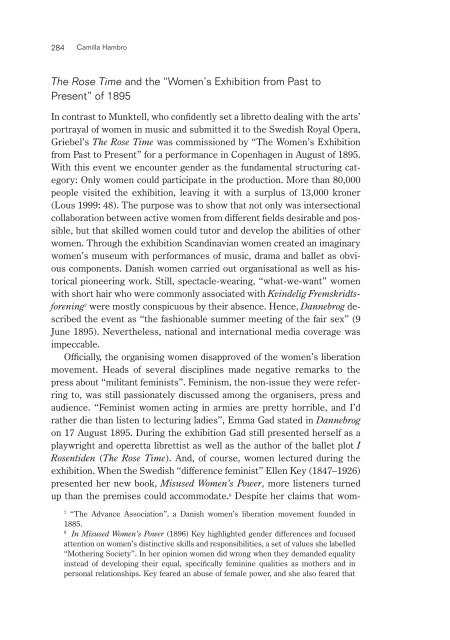Opera on the Move in the Nordic Countries during the Long 19th ...
Opera on the Move in the Nordic Countries during the Long 19th ...
Opera on the Move in the Nordic Countries during the Long 19th ...
Create successful ePaper yourself
Turn your PDF publications into a flip-book with our unique Google optimized e-Paper software.
284 Camilla Hambro<br />
The Rose Time and <strong>the</strong> “Women’s Exhibiti<strong>on</strong> from Past to<br />
Present” of 1895<br />
In c<strong>on</strong>trast to Munktell, who c<strong>on</strong>fidently set a libretto deal<strong>in</strong>g with <strong>the</strong> arts’<br />
portrayal of women <strong>in</strong> music and submitted it to <strong>the</strong> Swedish Royal <str<strong>on</strong>g>Opera</str<strong>on</strong>g>,<br />
Griebel’s The Rose Time was commissi<strong>on</strong>ed by “The Women’s Exhibiti<strong>on</strong><br />
from Past to Present” for a performance <strong>in</strong> Copenhagen <strong>in</strong> August of 1895.<br />
With this event we encounter gender as <strong>the</strong> fundamental structur<strong>in</strong>g category:<br />
Only women could participate <strong>in</strong> <strong>the</strong> producti<strong>on</strong>. More than 80,000<br />
people visited <strong>the</strong> exhibiti<strong>on</strong>, leav<strong>in</strong>g it with a surplus of 13,000 kr<strong>on</strong>er<br />
(Lous 1999: 48). The purpose was to show that not <strong>on</strong>ly was <strong>in</strong>tersecti<strong>on</strong>al<br />
collaborati<strong>on</strong> between active women from different fields desirable and possible,<br />
but that skilled women could tutor and develop <strong>the</strong> abilities of o<strong>the</strong>r<br />
women. Through <strong>the</strong> exhibiti<strong>on</strong> Scand<strong>in</strong>avian women created an imag<strong>in</strong>ary<br />
women’s museum with performances of music, drama and ballet as obvious<br />
comp<strong>on</strong>ents. Danish women carried out organisati<strong>on</strong>al as well as historical<br />
pi<strong>on</strong>eer<strong>in</strong>g work. Still, spectacle-wear<strong>in</strong>g, “what-we-want” women<br />
with short hair who were comm<strong>on</strong>ly associated with Kv<strong>in</strong>delig Fremskridtsforen<strong>in</strong>g<br />
7 were mostly c<strong>on</strong>spicuous by <strong>the</strong>ir absence. Hence, Dannebrog described<br />
<strong>the</strong> event as “<strong>the</strong> fashi<strong>on</strong>able summer meet<strong>in</strong>g of <strong>the</strong> fair sex” (9<br />
June 1895). Never<strong>the</strong>less, nati<strong>on</strong>al and <strong>in</strong>ternati<strong>on</strong>al media coverage was<br />
impeccable.<br />
Officially, <strong>the</strong> organis<strong>in</strong>g women disapproved of <strong>the</strong> women’s liberati<strong>on</strong><br />
movement. Heads of several discipl<strong>in</strong>es made negative remarks to <strong>the</strong><br />
press about “militant fem<strong>in</strong>ists”. Fem<strong>in</strong>ism, <strong>the</strong> n<strong>on</strong>-issue <strong>the</strong>y were referr<strong>in</strong>g<br />
to, was still passi<strong>on</strong>ately discussed am<strong>on</strong>g <strong>the</strong> organisers, press and<br />
audience. “Fem<strong>in</strong>ist women act<strong>in</strong>g <strong>in</strong> armies are pretty horrible, and I’d<br />
ra<strong>the</strong>r die than listen to lectur<strong>in</strong>g ladies”, Emma Gad stated <strong>in</strong> Dannebrog<br />
<strong>on</strong> 17 August 1895. Dur<strong>in</strong>g <strong>the</strong> exhibiti<strong>on</strong> Gad still presented herself as a<br />
playwright and operetta librettist as well as <strong>the</strong> author of <strong>the</strong> ballet plot I<br />
Rosentiden (The Rose Time). And, of course, women lectured dur<strong>in</strong>g <strong>the</strong><br />
exhibiti<strong>on</strong>. When <strong>the</strong> Swedish “difference fem<strong>in</strong>ist” Ellen Key (1847–1926)<br />
presented her new book, Misused Women’s Power, more listeners turned<br />
up than <strong>the</strong> premises could accommodate. 8 Despite her claims that wom-<br />
7 “The Advance Associati<strong>on</strong>”, a Danish women’s liberati<strong>on</strong> movement founded <strong>in</strong><br />
1885.<br />
8 In Misused Women’s Power (1896) Key highlighted gender differences and focused<br />
attenti<strong>on</strong> <strong>on</strong> women’s dist<strong>in</strong>ctive skills and resp<strong>on</strong>sibilities, a set of values she labelled<br />
“Mo<strong>the</strong>r<strong>in</strong>g Society”. In her op<strong>in</strong>i<strong>on</strong> women did wr<strong>on</strong>g when <strong>the</strong>y demanded equality<br />
<strong>in</strong>stead of develop<strong>in</strong>g <strong>the</strong>ir equal, specifically fem<strong>in</strong><strong>in</strong>e qualities as mo<strong>the</strong>rs and <strong>in</strong><br />
pers<strong>on</strong>al relati<strong>on</strong>ships. Key feared an abuse of female power, and she also feared that
















